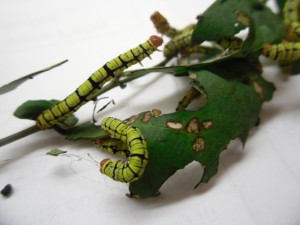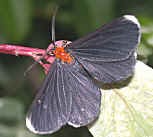Post prepared by Martha Glenn, Commercial Horticulture Agent

Do you have snowbush? Are they being eaten? If so you might want to look for these black and yellow inchworms (above). These guys are ferocious eating machines that love your snowbushes (Breynia spp.) but will also eat Malay gooseberry (Phyllanthus acidus), white sapote (Casimiroa edulis), and snow-on-the mountain (Euphorbia marginata). Usually your plants will recover from a light infestation of these caterpillars, sometimes called snowbush spanworms, but if you have a heavy infestation and no natural predators around, they will consume all the leaves and start eating the twigs and bark of the bushes. This could cause the death of your shrub.
So where do you think these spanworms come from? You are right if you think that snowbush spanworms hatch from eggs and start eating. When they have their fill of your bushes, they bury themselves in the ground and change into a pupa. In about seven days they emerge from the pupa as the white tipped black moth, Melanchroia chephise. These moths have velvety black wings with white tips spanning a little over one inch and an orange thorax (see below). You might even see them flying around your yard because unlike most moths, these little devils fly during the day instead of at night!
Now you might ask what to do about these spanworms. If you have a light infestation, predators such as parasitic wasps will be able to keep them in check. Consider wiping the eggs off your leaves or cutting a branch off that has caterpillars. If you feel that you need something else to control these critters, Spinosad or bacillus thuringiensis will work, but make sure you follow the directions.

 0
0
